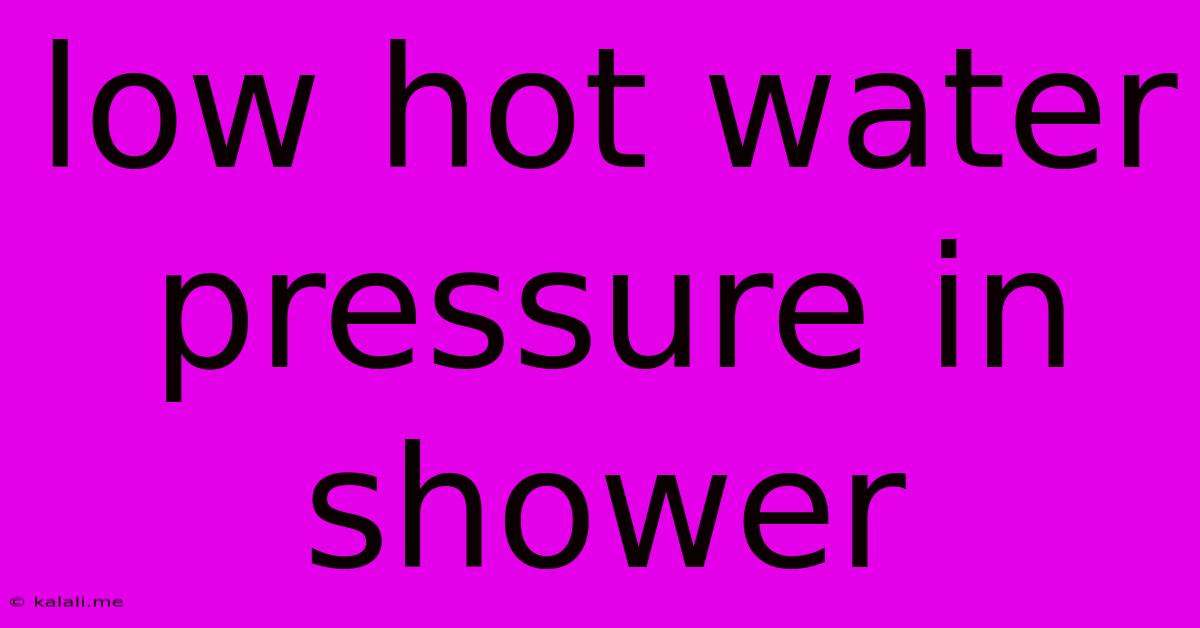Low Hot Water Pressure In Shower
Kalali
May 21, 2025 · 3 min read

Table of Contents
Low Hot Water Pressure in Shower: Troubleshooting and Solutions
A sputtering shower with weak hot water pressure can be incredibly frustrating. This article will guide you through troubleshooting the common causes of low hot water pressure in your shower, offering practical solutions to get your shower back to its invigorating best. Whether it's a sudden drop in pressure or a gradual decline, understanding the potential problems is the first step to fixing it.
Identifying the Source of the Problem
Before diving into solutions, it's crucial to pinpoint the exact cause of the low pressure. Is the problem limited to the hot water in your shower, or does it affect other hot water outlets in your home? This distinction helps narrow down the possibilities.
-
Shower-Specific Issues: If only your shower has low hot water pressure, the problem likely lies within the showerhead, the shower valve, or the plumbing directly supplying the shower.
-
House-Wide Hot Water Issues: If all hot water outlets (sinks, tubs, etc.) exhibit low pressure, the problem might stem from your water heater, the main water supply line, or even sediment buildup in your pipes.
Common Causes and Solutions
Let's explore the most frequent culprits behind low hot water pressure in your shower and how to tackle them:
1. Clogged Showerhead: Mineral deposits, soap scum, and other debris can accumulate in the showerhead's tiny nozzles, restricting water flow.
- Solution: Remove the showerhead and soak it in a mixture of white vinegar and water. A toothbrush can help scrub away stubborn buildup. If the clogging is severe, consider using a descaling solution.
2. Faulty Shower Valve Cartridge: The cartridge is a crucial component of your shower valve, regulating water flow and temperature. Wear and tear or mineral deposits can affect its performance.
- Solution: This is a slightly more complex repair, often requiring replacing the entire cartridge. Consult online tutorials or a plumber if you're unsure about the process. Note your shower valve model number for easy replacement part sourcing.
3. Low Water Pressure from the Main Supply: This issue impacts all hot water outlets and suggests a problem outside of your shower.
- Solution: Check your main water meter to see if it's registering a low flow. If so, contact your water utility company. Also, examine your main water supply line for leaks or blockages.
4. Sediment Buildup in Pipes: Over time, minerals in your water can accumulate inside your pipes, reducing water flow.
- Solution: This usually requires professional help. A plumber might use a specialized tool to flush the pipes and remove the sediment. Regular water softener use can prevent this problem from recurring.
5. Water Heater Issues: If your water heater is malfunctioning, it can lead to low hot water pressure. This could be due to a failing heating element, a thermostat problem, or simply a need for routine maintenance.
- Solution: Check your water heater's temperature setting. Ensure adequate ventilation around the unit. If the problem persists, consult a qualified technician for professional inspection and potential repairs.
6. Restricted Hot Water Supply Line: A kink, blockage, or narrowing in the pipe supplying hot water to your shower will directly impact pressure.
- Solution: Inspect the pipe carefully for any obvious obstructions or damage. If the problem is a kink, carefully try to straighten the pipe, however severe restriction necessitates professional intervention.
When to Call a Plumber
While some issues can be resolved with DIY solutions, others necessitate the expertise of a qualified plumber. Don't hesitate to call a professional if:
- You're uncomfortable working with plumbing.
- The problem persists despite your troubleshooting efforts.
- You suspect a leak in your main water supply line.
- You are dealing with extensive mineral buildup in your pipes.
Addressing low hot water pressure promptly not only improves your showering experience but can also prevent more significant plumbing problems down the line. By following these steps and understanding the potential sources of the issue, you can effectively restore satisfying water pressure in your shower.
Latest Posts
Latest Posts
-
How Did Amon Take Away Bending
May 21, 2025
-
How To Insulate A Shed Floor
May 21, 2025
-
Full Stop Before Or After Bracket
May 21, 2025
-
How Much Is Half A Million
May 21, 2025
-
Wire A 2 Gang 2 Way Switch
May 21, 2025
Related Post
Thank you for visiting our website which covers about Low Hot Water Pressure In Shower . We hope the information provided has been useful to you. Feel free to contact us if you have any questions or need further assistance. See you next time and don't miss to bookmark.